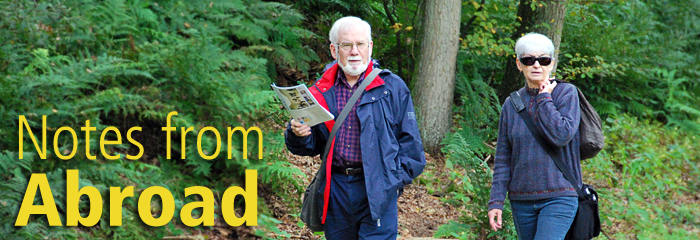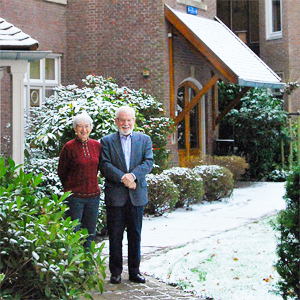
Patrick Glenn, visiting fellow at the Netherlands Institute for Advanced Study, reports on life in Wassenaar, from learning Dutch to keeping up with the locals on bicycles
Jane Glenn and I are presently enjoying life as guests of the Netherlands Institute of Advanced Studies (NIAS) and the Hague Institute for the Internationalization of Law (HiiL). We are located in the small town of Wassenaar, which is about mid-way between The Hague and Leiden, in the south-west of the Netherlands, in the province of South Holland. The Netherlands is a small country (though with a population half the size of Canada’s) but we have learned to ‘think small’ and a trip to Amsterdam is now a major undertaking. We are going for the first time in late November, after three months here. Even going to The Hague (a half hour on the bus) requires deliberation and planning.

One of the joys of thinking small is that most travel here is done on bicycles. Our flat (kindly provided by NIAS) came equipped with two lovely Batavus 4-speed bicycles, equipped with large saddle-bags, lights and bells, and we use them every day. Our trip from the flat in Wassenaar to NIAS is about a 12 minute ride and takes us through tulip fields (now ploughed under for the winter), a golf course (play still going on in late November), a small farm with grazing sheep, and a small forest (with very expensive houses scattered through it). It is a lovely ride. Our longest trip to date has been to Leiden (about an hour there and back). We are contemplating The Hague, and Katjwick on the coast. Getting anywhere thus requires deliberation and choice. Will it be bicycle, bus or train, or some combination of them? The downside of bicycling though is that however much we huff and puff, Dutch people are constantly zinging by us, even little old ladies chatting among themselves as they cruise along at thirty kilometres an hour, into the wind!
As guests, we benefit from an entire programme of cultural activities, laid on for the forty or so fellows who are here every year. We have been to a trip to the dunes (which protect that large part of the Netherlands which is below sea level) and heard lectures on water management. Most of the middle of The Netherlands is built on peat, and as water is drained away the peat shrinks, so that the ground level is constantly sinking and needs to be refilled with fresh earth. I don’t know how they do that with buildings (they must use very deep piles, since the peat is some 30 metres deep) but we were told that municipalities regularly deliver earth to people to build up the level of their gardens. Another trip was to the magnificent Kroeller-Muller sculpture and art museum (van Gogh originals everywhere you look) near Arnhem. Next week we go to an artists’ studio in Amsterdam to see contemporary art in full production and two weeks after that to The Hague to see the ‘other’ Hague, the immigrant quarters which give rise to so much controversy about the multicultural policy of the Netherlands.
When we arrived here there was no government since the far-right party had greatly increased its percentage of the vote and some accommodation had to be reached with them for a government to be formed. They reached a loose modus vivendi, with the far-right not actually in the government but agreeing to support it on most issues. It is all very fragile. The leader of the far-right party has been charged criminally with hate-speech and has been getting a great deal of publicity. The prosecution has withdrawn the present charges but proceedings may not be over.
We have been making efforts to learn Dutch but it is very difficult when everyone (or nearly everyone) speaks perfect, North-American accented English. Television programmes here are often presented in the original language with Dutch sub-titles, which means you can watch an English or French movie and learn some Dutch from the sub-titles running below. Dutch is easier than German (no declensions) but it has a rich vocabulary of its own so requires a lot of time to acquire any fluency. A year won’t be enough but we are now managing to read a lot of travel and other instructions.
Dutch society is very well-organized. To my amazement I found that cheques have been eliminated, with all payments being made electronically from computer to computer. Cash is declining in importance with use not only of debit cards but of ‘chip cards’, which you load with cash at a bank and then use to pay for all kinds of small purchases. They are behind, however, on recycling, with no pick-up at individual houses and only deposit points (and even then only for plastic, glass and paper and nothing for metal or aluminum cans).
There is hope that the winter will be cold and that the canals will freeze, giving rise to the famous 11-city canal-skating race. People are talking about it already. There are advantages, however to the warmer winters. Sitting on our balcony in September we suddenly saw a brilliant green parrot land in the tree just in front of us, shortly joined by a dozen others — just like the famous parrots of Telegraph Hill in San Francisco. A Dutch fellow told us there are parrot flocks all over The Netherlands, the result of escapes or releases from home, and milder weather to help the offspring. I was once greeted by a hotel parrot in New Orleans with the inviting words ‘Hel-lo, baby’ and we may try to teach the whole flock to say it, so it will spread over the whole country.
Best wishes from Wassenaar!
Patrick Glenn
